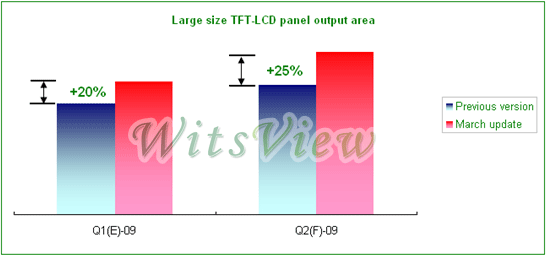Popular Keywords
- About Us
-
Research Report
Research Directory
Semiconductors
LED
Consumer Electronics
Emerging Technologies
- Membership
- Price Trends
- Press Center
- News
- Events
- Contact Us
Taipei, April 7, 2009---For Apr09, as downstream clients continue to replenish their inventory and prepare the launch of new models, coupled by the still tight supply of some components, panel prices will remain on an upward trend. Demand for the 40W and below TV panels has been strong, especially in the China local sales. This causes capacity allocation problems between the TV and monitor panels in the G6 lines, which are currently mainly responsible in producing the latter. Thus, amid the continued 16:9 monitor panel shortage, which will help support further price increases, it will also help push up the 26W and 32W TV panel prices. The two TV sizes may thus be able to return to the cash cost level in 2Q09, according to WitsView's analysts.
Meanwhile, given the development trend of eco-friendly products, the penetration rate of 16:9 white LED NBs will increase more notably since 2Q09, as major PC vendors begin to launch such products in replacing the traditional 16:10 CCFL models. Previously, panel makers adopted an aggressive pricing policy for their LED NB panels in order to more rapidly expand their market share. But in the first half of each year, it is usually a slow season for the NB market. At the moment, there is still a more than $5 cost difference between CCFL and white LED NB panels. With the LED NB panel price already lower than the cash cost, panel makers have been forced to readjust their pricing strategy. For Apr09, there is a chance for the LED NB panels to see a small price increase, especially for the mainstream 15.6W. Separately, panel makers are also trying to raise the panel prices of the 16:10 panels. Yet, the still low G5 utilization rates and ongoing inventory clearing at overall supply chain will make this unlikely.
In China, major TV vendors are aggressively preparing for the upcoming Labor Day holidays. As a high portion of the demand is concentrated on the 32W and below, supply from the G6 lines has been tight. For the G7 and above, their contribution to the glass substrate consumption has been limited, thereby increasing the price pressure on the 40W and above. On a different note, China government is studying to raise the RMB 2,000 subsidy for electronic products in rural areas to RMB 3,500. The bidding process is set to begin in 2HApr. The subsidy increase should allow TV sizes applicable under the program to now encompass the 42W and below instead of the previous 32W and below. As the subsidy program currently has no limit on the number of purchases, after the inventory preparations have been completed, it is worthy to see how the actual end market sales will be.
Recently, there have been market rumors of China-based panel maker SVA nearing bankruptcy and the Shanghai city government setting up a task force in dealing with the matter. The mainstream products produced by SVA are the 15.6W and 19W, which account for a mere 2~3% of the global market share. Meanwhile, as there is still a 200K production plan amid the ongoing restructuring, the impact on the panel supply should be limited for the time being.
In general, many market uncertainties still exist in 2Q09. First, the second quarter is usually the traditional slow season for electronic products. Despite the decisions made by the G20 economies in battling the financial crisis, unemployment rates continues to increase. The pace of the economic recovery still needs to be closely observed. At the moment, most of the panel demand is coming from clients’ inventory replenishments. Thus, it is anticipated the demand will enter a readjustment phase in mid 2Q09 to the start of 3Q09. Separately, amid the panel price increase stemming from the influx of rush orders, aside from allowing the Korean panel makers to maintain high utilization rates, the Taiwan and China panel makers have also been able to raise the glass input as well. This is most evident for the G6 and above lines. However, once the tight component supply becomes more stable, a market oversupply may still occur in the wake of the traditional weak seasonality. As the mid-year inventory accounting and quarterly end also occurs during the second quarter, it will not be a conductive factor to the near-term panel price trend. Nevertheless, we still hold a cautiously upbeat market outlook toward the TFT LCD industry development in 2H09.

About WitsView
Founded in the year 2004, WitsView, a subsidiary brand of DRAMeXchange, is composed of a team of TFT-LCD industry experts. The research field covers the development and market trend of upstream components, mid stream panels and downstream system integrators and retailers.
For more about WitsView, please visit www.witsview.com
Subject
Related Articles
Related Reports

